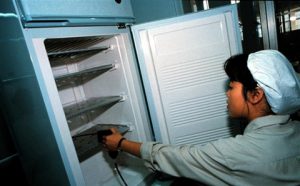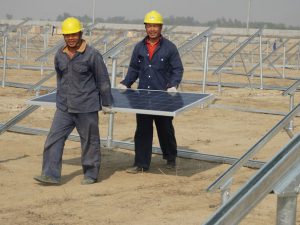The landmark Paris Climate Agreement is on track to pass its first real test as governments in Vienna inch closer to an agreement to cut hydrofluorocarbons (HFCs), highly potent greenhouse gases that, if unchecked, would wipe out much of the carbon savings made elsewhere, such as the energy sector.
Early in the meetings, the Parties agreed to language on finance, intellectual property, and linkages to hydrochlorofluorocarbons (HCFCs) – ozone depleting substances are already being phased out under the 1987 Montreal Protocol.
Progress was later made on narrowing the range of baseline and consumption freeze dates for developing countries; however, there remains significant divergence between countries on the climate ambition of the agreement.
HFCs are used in refrigerants and air-conditioning, sectors that are growing fast in developing countries. The compounds have global warming potentials (GWP) many hundreds to thousands of times higher than carbon dioxide.
Countries are moving in the right direction but there is a huge amount of work to be done to finalise an ambitious amendment at a high level meeting in Kigali, Rwanda in October.
Discussions on the HFC schedule for developed countries lacked the ambition expected, given that these countries are in a position to fully understand their current HFC consumption and are already taking domestic action to phase down HFCs. Climate leadership needs to be demonstrated through an ambitious commitment from the developed countries, not just words.
HFC use has rapidly increased in developing countries as the chemicals replace ozone-depleting substances (ODS) currently being phased out under the Montreal Protocol. But with the world poised to install 700 million air-conditioners by 2030 and 1.6 billion by 2050, HFC emissions will outstrip future measures to cut carbon from the energy sector unless immediate action is taken.
In China, the world’s largest producer of air-conditioning equipment and a major producer of refrigerant chemicals, total HFC emissions grew from 8.1 million tonnes of CO2-equivalent per year in 2006 to 113 million by 2013. Growth rates of high-GWP HFCs (e.g. HFC-143a, with a GWP of 5080) are as high as 100% a year.
Underpinning the Montreal Protocol agreement is a desire to avoid as much of this growth as possible and to gradually reduce existing HFC consumption. A near-term freeze of use in developing countries is essential to the success of this approach.
Fortunately, alternatives to HFCs are available for all key uses and the Montreal Protocol has a proven track record in effectively enabling developing countries to switch from ODS to less damaging alternatives.
The key challenge is to ensure these technologies are sufficiently proven in developed countries so they can be swiftly taken up by developing countries with support in terms of finance, training and industry standards – thus, all the proposals to the Montreal Protocol envisage an early phase-down for developed countries, with developing countries taking action later.
“Carbon bomb”
An additional major challenge is the cooling industry’s energy demand. Energy consumption for cooling in an ever more populous, urbanised and warming world is set to dramatically increase global energy demand, overtaking the amount used for heating by 2060. As such, simultaneously investing in energy-efficient low-GWP technologies could yield significant climate co-benefits and it is imperative HFC alternatives do not come with energy penalties attached.
In the past, technology choices within the framework of the Montreal Protocol have been dominated by the very same fluorochemical companies whose products created the ozone hole in the first place – finally accepting the problem, they quickly offered new synthetic solutions even though it was acknowledged that some, such as HCFCs, were only transitional and would eventually need replacing too.
These companies are supporting efforts under the Montreal Protocol to phase down HFCs but they want a very gradual process, allowing them plenty of wiggle room to market their range of new HFC mixtures with lower GWP rather than a fast phase-down requiring countries to move directly to very low- or zero-GWP alternatives.
Alternatives
Given the climate imperative, greater efforts need to be given to incentivise the direct transitions to very low-GWP solutions such as natural refrigerants (e.g. hydrocarbons, carbon dioxide and ammonia).
For example, multiple studies show propane is the most efficient replacement for air-conditioning – it is also cheap, free of intellectual property issues and works in high ambient temperatures. China has repeatedly flagged the need to address outdated industry standards which prevent the use of flammable refrigerants such as propane while creating market barriers to their safe uptake.
One inspiring example of how to do it right has been the growth of climate-friendly technologies in the commercial refrigeration sector.
In 2008, EIA began to quiz UK supermarkets on the sustainability of their refrigeration. In its first year, the “Chilling Facts” campaign found just six retailers trialling natural refrigerant alternatives to HFCs and a mere 14 stores using them. The leakage of HFCs from their systems was huge, often outweighing all the emissions associated with powering the refrigeration equipment.
Corporate action
Supermarkets initially cited many obstacles to going HFC-free, from costs and a shortage of engineers trained to handle natural refrigerants to concerns over increased energy consumption. But by elevating the issue to boardroom level via EIA’s ongoing campaign and the media attention it secured, retailers were able to address barriers which had appeared insurmountable.
Leading UK retailers, including Sainsbury’s and Waitrose, committed to stop using HFCs in new equipment and, in subsequent years, EIA found other retailers from across Europe moving away from HFCs, helped by a 2010 Consumer Goods Forum Resolution calling on its 400-plus members in 70 countries to start phasing out HFCs and replace them with natural refrigerants by 2015.
Now, just eight years on, Europe has more than 5,500 supermarkets using ‘CO2 transcritical systems’ (which use no HFCs) – and industry experts expect this shift to continue.
With studies suggesting we have as few as five years at current global emissions levels before the option to limit warming to 1.5C is lost, we can only hope that the desire to achieve an HFC agreement is matched by the political will to make it as ambitious as possible.








